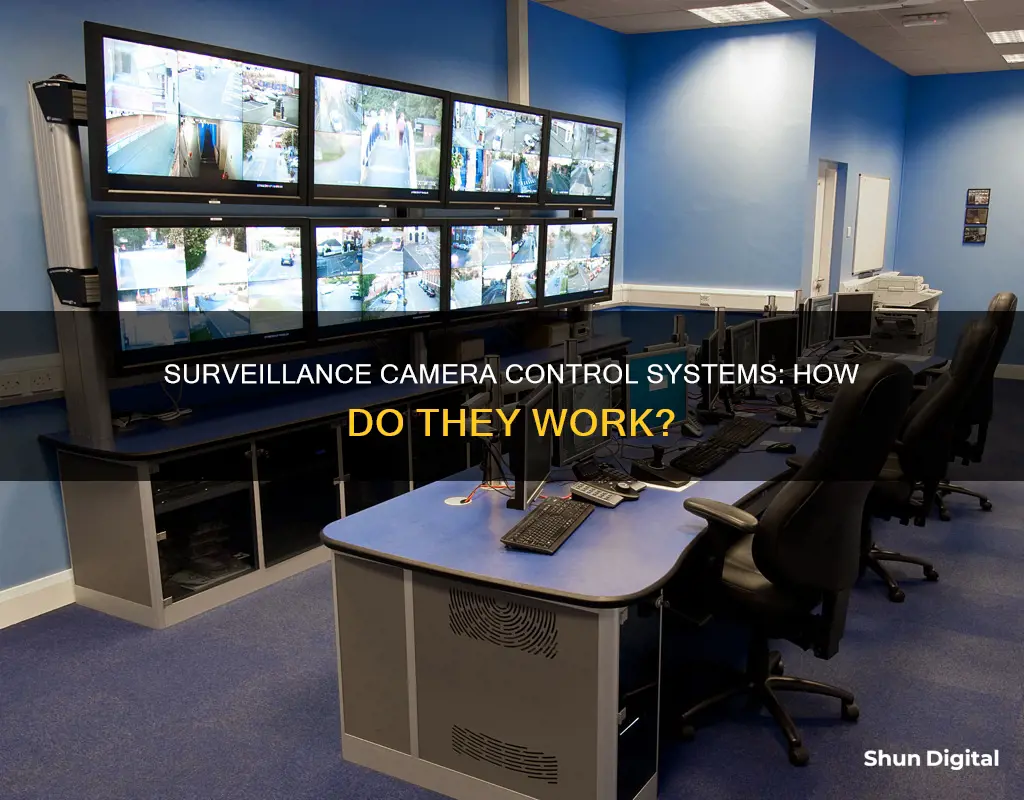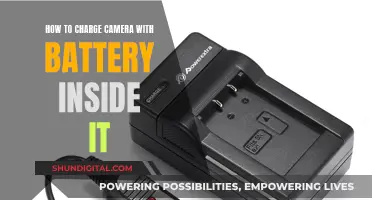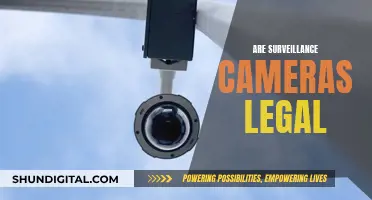
Surveillance camera control systems are used to monitor an area for security purposes. They are often connected to a recording device or IP network and may be observed by a security guard or law enforcement officer. There are two types of security camera systems: Analog and IP (or network cameras). Analog surveillance systems are the most common type, with cameras connected directly to a digital video recorder, while IP surveillance systems have cameras that function as their own DVR, compressing and converting video to a digital format that can be streamed over ethernet.
| Characteristics | Values |
|---|---|
| Purpose | Information gathering, influencing, managing, or directing |
| Observation methods | Electronic equipment (e.g. CCTV), interception of electronically transmitted information, human intelligence gathering, postal interception |
| Users | Citizens, governments, criminal organizations, businesses, religious organizations, auditors |
| Concerns | Violation of privacy, ethical concerns, cost |
| Types | Analog, IP/network |
| Features | Live streaming, facial recognition, motion detection, night vision, two-way talk, etc. |
| Recording | Local, cloud |
What You'll Learn
- Surveillance cameras are used to visually monitor an area
- There are indoor and outdoor security cameras
- Surveillance systems can range from wireless home security cameras to sophisticated alarm systems
- Surveillance systems are an essential part of securing your home or business
- Surveillance cameras can be wired or wireless

Surveillance cameras are used to visually monitor an area
There are two main types of security camera systems: Analog and IP (sometimes referred to as network cameras). Analog surveillance systems are the most common type, where cameras are connected directly to a digital video recorder (DVR) and the footage is stored on a hard drive. IP surveillance systems, on the other hand, have each camera acting as its own DVR, compressing and converting the video to a digital format that can be streamed over a network.
Surveillance cameras can be used for both indoor and outdoor security and come with a variety of features, such as live streaming to a mobile phone, facial recognition, and motion detection. The placement of cameras will depend on the specific needs of the user, such as monitoring employees or documenting visitors to a home.
The use of surveillance cameras has become increasingly common, with an estimated 350 million surveillance cameras worldwide as of 2016. This growth has been fuelled by cheaper production techniques, making surveillance cameras simple and inexpensive enough for home security systems and everyday surveillance.
The benefits of surveillance cameras include deterring crime, monitoring and influencing behaviour, and providing evidence in the event of an incident. However, there are also concerns about the potential invasion of privacy and the need for regulations to restrict governmental and private use of surveillance.
How Masking in Adobe Camera Raw Transforms Photos
You may want to see also

There are indoor and outdoor security cameras
Surveillance camera control systems are used to monitor behaviour and gather information. There are two types of security camera systems: Analog and IP (or network cameras). Analog systems are the most common type of security camera on the market and are connected directly to a digital video recorder (DVR). IP systems, on the other hand, are more advanced and can compress video, convert it to a digital format, and stream it over ethernet.
Outdoor cameras are designed to withstand heavy rain, snow, and extreme temperatures. They can be wired or wireless and are usually connected to a recording device or IP network. They may be monitored by a security guard or law enforcement officer.
When choosing between a wired or wireless system, it's important to consider the placement of the cameras and components. Wired systems require drilling holes and running wires, while wireless systems use Wi-Fi and offer more flexibility.
Some features of indoor/outdoor security cameras include:
- Waterproof or weatherproof design
- Night vision or colour night vision
- Motion detection
- Two-way audio
- Rechargeable battery
- High-definition video
- Cloud and/or SD storage
Are Camera Batteries Safe for Flying?
You may want to see also

Surveillance systems can range from wireless home security cameras to sophisticated alarm systems
Surveillance systems are an essential part of securing your home or business. They can range from simple wireless home security cameras to sophisticated alarm systems that notify law enforcement at the first sign of trouble.
Wireless home security cameras are easy to install and offer great versatility, but they require regular battery changes and a strong Wi-Fi signal. Wired systems, on the other hand, provide a consistent and uninterrupted connection but are more difficult and expensive to install.
When choosing a surveillance system, you should consider factors such as the size of the area you want to monitor, your specific security needs, budget, and whether you prefer professional installation and monitoring or a DIY setup.
Some of the most popular surveillance systems on the market include SimpliSafe, Vivint Smart Home, Ring Alarm, and Comcast Xfinity Home. These systems offer features such as motion detection, night vision, two-way audio, and smart home integration.
In addition to wireless and wired systems, there are also hidden cameras that can be discreetly fitted into everyday objects like clocks, smoke detectors, and magnets. These can be useful when mounting cameras inside your house is not an option.
Alarm systems are another crucial component of surveillance. They can range from basic burglar alarms to sophisticated systems that integrate fire, medical alert, and home automation features. When choosing an alarm system, you should consider whether you want a wired or wireless system, monitored or unmonitored, and the specific features you need, such as fire, carbon monoxide, or flood detection.
Surveillance camera systems can also vary in terms of video storage. Some systems offer local storage through a hub or microSD card, while others provide cloud storage, usually for a subscription fee.
Overall, when selecting a surveillance system, it's important to consider your specific needs, budget, and the level of security and convenience you require.
Surveillance Footage Retention: Hospitals' Camera Data Storage Limits
You may want to see also

Surveillance systems are an essential part of securing your home or business
For businesses, it is critical not to compromise on quality when it comes to security camera systems. Investing in a higher-end surveillance system that offers high-definition image capture, video recording, and monitoring is essential. Network video recorders have become the standard for most business surveillance needs, offering excellent video quality and ample storage space. Commercial-grade NVR or DVR systems are recommended, providing ample storage capacity, cloud storage options, camera compatibility, and advanced video compression technology.
Business security cameras should also offer higher frame rates for smooth video, ensuring clear footage of any incidents. Additionally, features like mobile notifications, automatic recording, motion sensors, and direct connections to law enforcement can enhance security and provide peace of mind.
For homes, installing security cameras is one of the simplest ways to protect your property and loved ones. Homes without security systems are three times more likely to be broken into. Remote video monitoring is a key feature, allowing homeowners to check on their property from anywhere via smartphone or tablet. Vandal-proof and weather-resistant cameras are also important, especially for monitoring outdoor areas.
Motion detection and night vision features are crucial for alerting homeowners to any suspicious activity. Fixed cameras focus on specific areas, while adjustable cameras can scan larger areas, making them ideal for monitoring backyards or garages.
Whether for home or business, surveillance systems offer an added layer of protection, deterring burglars and providing valuable footage in the event of an incident. They are a worthwhile investment to safeguard your property, possessions, and most importantly, your loved ones.
Samsung S7 Edge: Exploring the Macro Camera Mode
You may want to see also

Surveillance cameras can be wired or wireless
Wired security cameras transmit video and audio signals through a wire to a central hub, which can be a digital video recorder (DVR) or a networked video recorder (NVR) system. The hub may be located in or around the home, and the footage can be stored locally on the hub or sent outside of the home to a network. Wired security cameras receive electrical power either directly from a power outlet or through the wire that connects to the central hub (known as Power Over Ethernet or PoE cable).
The main advantage of wired camera systems is the reliability of the feed to the hub. As long as the wire is intact, the hub should receive the feed uninterrupted and at maximum fidelity. Wired systems are also less susceptible to hacking since they are not connected to the internet. Additionally, wired cameras can work well for multiple camera installations throughout the house and exterior as the signal will not be impeded by walls.
However, the major downside of wired security cameras is the installation process, which can be time-consuming and costly. Between four and 16 cameras may need to be set up, and the wires, which can be hundreds of feet long, must be hidden by fishing them through walls, ceilings, or crawl spaces. Wired cameras are also not portable and will remain with the house if the owner moves.
Wireless security cameras, on the other hand, transmit footage from cameras placed around the house to the home's Wi-Fi, and the transmission is completely wireless. Once the Wi-Fi receives the signal, it is sent to a cloud server, where footage can be viewed in real-time or archived for later viewing. Wireless cameras are typically powered through AC power or batteries, and some models have onboard micro SD cards for limited local storage.
The flexibility and ease of installation are the main benefits of wireless security cameras. They can be easily rearranged or moved to a new location, making them ideal for renters. Wireless cameras also do not require drilling or running wires through walls, making the setup process faster and less invasive. Additionally, with no wires between the cameras and the hub, there is nothing for intruders to cut.
However, wireless security cameras rely on a clear and uninterrupted signal, and their performance can be affected by the range and the quality of the Wi-Fi connection. Denser building materials like brick or concrete can impede the signal. Wireless cameras are also more vulnerable to digital snooping and hacking compared to wired cameras. Power management can be another issue, as battery-powered cameras require regular battery changes, and plug-in cameras need to be placed near an outlet.
Both wired and wireless security cameras have their strengths and weaknesses, and the choice between the two depends on the user's specific needs and expectations. Wired cameras offer greater reliability and security but require more setup time and effort. Wireless cameras, on the other hand, are inexpensive, flexible, and quick to install but may face issues with network failure and on-site tampering.
The Longevity of Roku's Outdoor Camera Battery Power
You may want to see also
Frequently asked questions
A surveillance camera control system is a setup where multiple security cameras are connected to a single cloud-managed platform, which can be accessed from anywhere on any device.
There are two main types of surveillance camera systems: Analog and IP (or network cameras). Analog systems use standard security cameras connected directly to a DVR, while IP systems have cameras that function as their own DVR and can stream video over ethernet.
When choosing a surveillance camera system, consider the video and audio quality, field of view, night vision capabilities, storage options, smart features such as person detection or facial recognition, and whether the system is wired or wireless.







